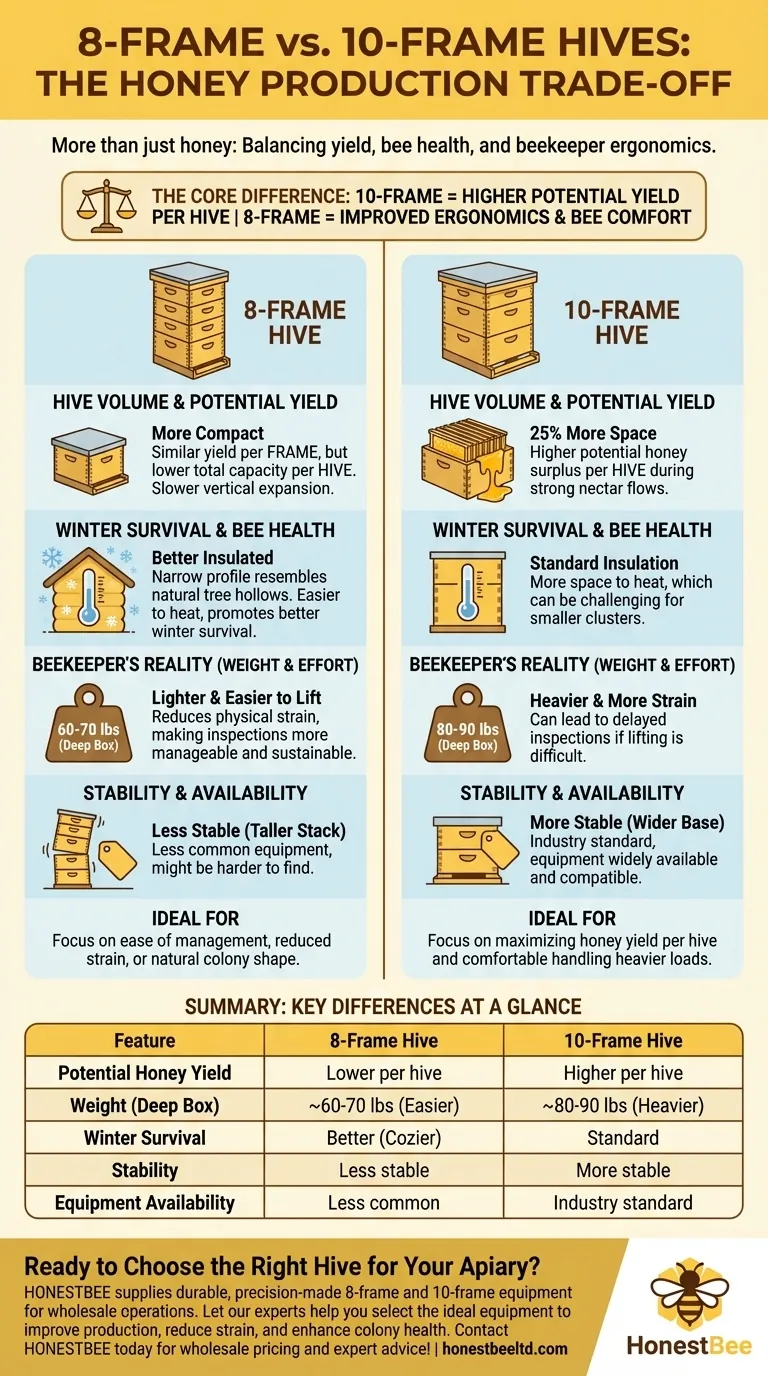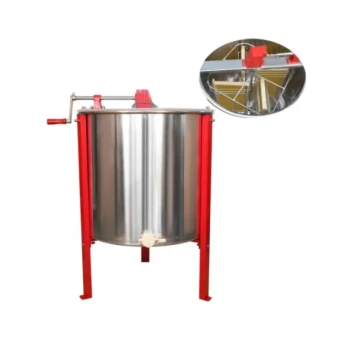On paper, a 10-frame hive will produce more honey. With 25% more space for brood and resources in each box, a strong colony can leverage this extra room for greater honey storage. However, this simple answer overlooks the more critical factors that truly determine a successful honey harvest: bee health and beekeeper effectiveness.
The choice between an 8-frame and a 10-frame hive is not a simple question of honey production. It is a fundamental decision that balances the potential for higher yield per hive (10-frame) against improved ergonomics and bee comfort (8-frame).

The Core Difference: Space and Its Consequences
The most obvious distinction between the two systems is size. This single variable creates a cascade of effects that impact everything from bee behavior to your ability to manage the colony.
How Hive Volume Impacts Potential Yield
A standard deep 10-frame Langstroth box has more room for bees to raise brood and store honey. This larger population and storage capacity can translate directly into a larger honey surplus during a strong nectar flow.
Bees also tend to fill the space in an 8-frame box more completely before moving up into the next super. While this can result in beautifully drawn-out frames, it may slightly slow the colony's vertical expansion compared to a 10-frame hive.
Why More Space Isn't Always Better for Bees
The more compact, narrower profile of a stacked 8-frame hive more closely resembles the hollow trees wild honeybees naturally colonize. This can be a significant advantage for the colony, especially during winter.
The smaller space is easier for the bees' cluster to heat efficiently. It also ensures the cluster can more easily stay in contact with its honey stores as it moves upward throughout the cold months, which is critical for winter survival.
Honey Production in the Real World
Theoretical maximums rarely tell the whole story. In practice, the difference in honey yield is often less about the box and more about the bees and the beekeeper.
Yield Per Hive vs. Yield Per Frame
A single, thriving 10-frame hive will likely produce more honey than a single, thriving 8-frame hive in the same apiary.
However, many beekeepers find that the honey production per individual frame is nearly identical between the two systems. The most productive hive is always the one that is healthiest and managed most effectively.
The Beekeeper's Physical Limit
The most significant factor for many beekeepers is weight. A full, deep 10-frame hive box can weigh 80-90 pounds, while an 8-frame deep is closer to 60-70 pounds.
If a beekeeper struggles to lift the heavier boxes, they may delay or avoid necessary inspections. This can lead to missed swarm signs or health issues, which will devastate honey production far more than the choice of equipment.
Understanding the Critical Trade-offs
Choosing a hive system is an exercise in balancing competing priorities. There is no single "best" answer, only the best fit for your specific situation.
Winner for Ergonomics: 8-Frame
The reduced weight is the primary reason many beekeepers switch from 10-frame to 8-frame hives. Lighter boxes make inspections easier, reduce physical strain, and can make beekeeping a more sustainable and enjoyable long-term hobby.
Winner for Winter Survival: 8-Frame (Slight Edge)
The narrower hive body provides a cozier, better-insulated home that makes it easier for the bee cluster to manage temperature and access food stores during the winter.
Winner for Stability: 10-Frame
Because an 8-frame hive must be stacked taller to provide the same internal volume, it has a higher center of gravity and is more prone to tipping in high winds or if knocked by animals. The wider base of a 10-frame hive is inherently more stable.
Winner for Equipment Availability: 10-Frame
The 10-frame Langstroth is the de facto industry standard in many regions. This means equipment is often easier to find, sometimes less expensive, and more compatible if you plan to buy or sell bees or equipment from other beekeepers.
Making the Right Choice for Your Goal
Ultimately, the equipment should serve your goals and capabilities, not dictate them. A well-managed hive of either size will produce honey.
- If your primary focus is maximizing honey yield per hive and you can comfortably handle the weight: The 10-frame hive offers the highest potential volume for production.
- If your primary focus is ease of management, physical comfort, or a more natural colony shape: The 8-frame hive is an excellent choice that reduces strain and may improve wintering success.
- If your primary focus is overall apiary production: The difference can be minimal. The honey you lose per hive with 8-frame equipment can be offset by keeping more, easier-to-manage colonies.
The best beehive is the one that you can manage effectively, allowing your colonies to thrive.
Summary Table:
| Feature | 8-Frame Hive | 10-Frame Hive |
|---|---|---|
| Potential Honey Yield | Lower per hive, similar per frame | Higher per hive (more space) |
| Weight (Deep Box) | ~60-70 lbs (easier to lift) | ~80-90 lbs (more strain) |
| Winter Survival | Better (easier to heat, natural shape) | Standard |
| Stability | Less stable (taller stack) | More stable (wider base) |
| Equipment Availability | Less common | Industry standard, widely available |
Ready to Choose the Right Hive for Your Apiary?
Whether you're a commercial apiary focused on maximizing honey yield or a distributor seeking reliable, high-quality equipment, the right hive system is key to your success. At HONESTBEE, we supply durable, precision-made 8-frame and 10-frame beekeeping supplies and equipment through our wholesale-focused operations.
Let our experts help you select the ideal equipment to improve your honey production, reduce physical strain, and enhance colony health.
Contact HONESTBEE today for wholesale pricing and expert advice tailored to your operation!
Visual Guide

Related Products
- Langstroth Bee Hives Bee Keeping Box for Beginners Beekeeping
- Wholesales Dadant Size Wooden Bee Hives for Beekeeping
- Long Langstroth Style Horizontal Top Bar Hive for Wholesale
- Professional Galvanized Hive Strap with Secure Locking Buckle for Beekeeping
- HONESTBEE Advanced Ergonomic Stainless Steel Hive Tool for Beekeeping
People Also Ask
- How does the ease of access differ between 8-frame and 10-frame hives? Choose the Right Hive for Your Body
- How does the orientation of the hive sides benefit comb construction? Ensure Straight, Movable Combs for Easier Hive Management
- Why are Langstroth hives recommended for beginners? Unmatched Support & Standardization
- What is the best type of bee hive for beginners? Start with the Proven Langstroth Standard
- Why might a beginner be advised to start with a Langstroth hive? Unlock a Supportive Beekeeping Ecosystem



















